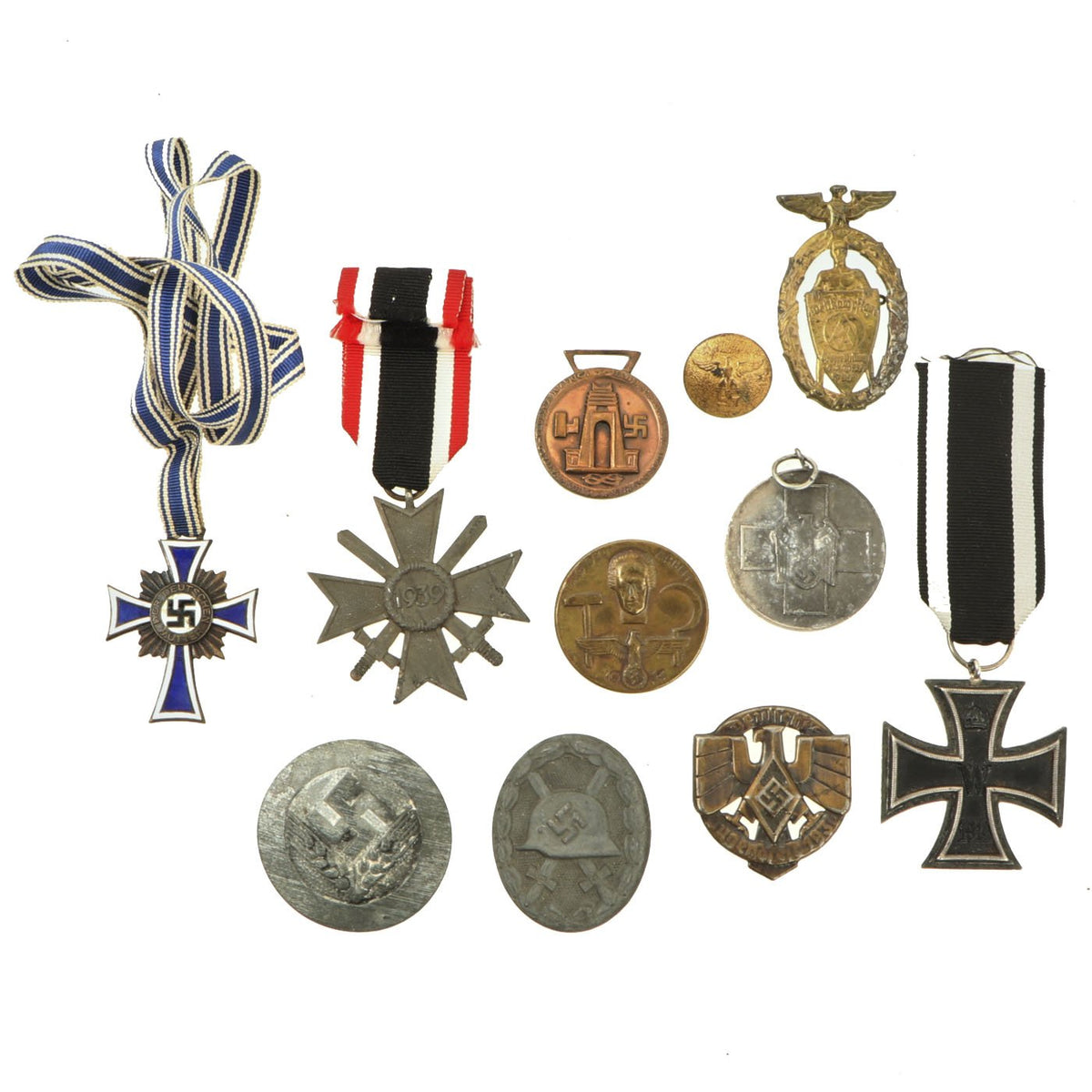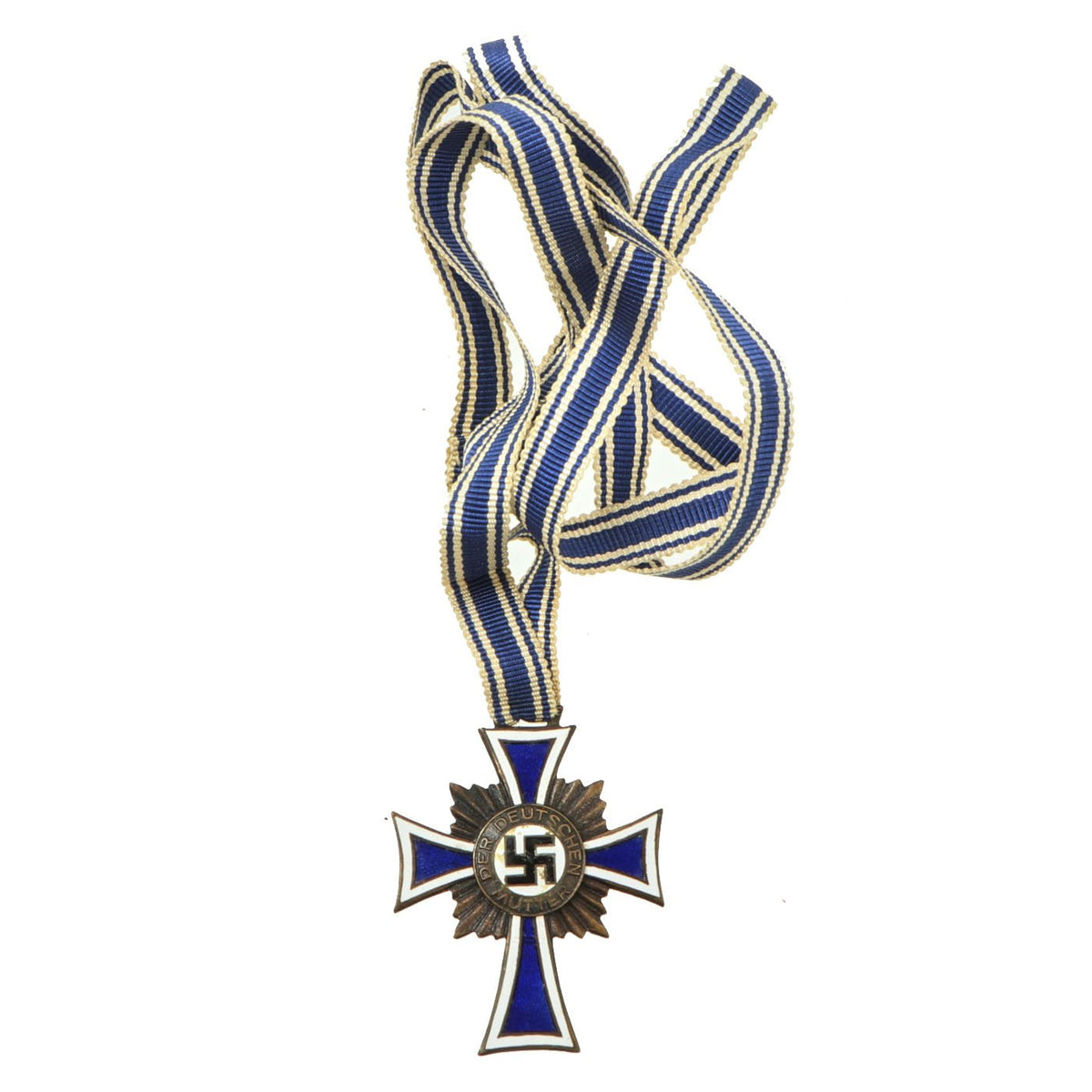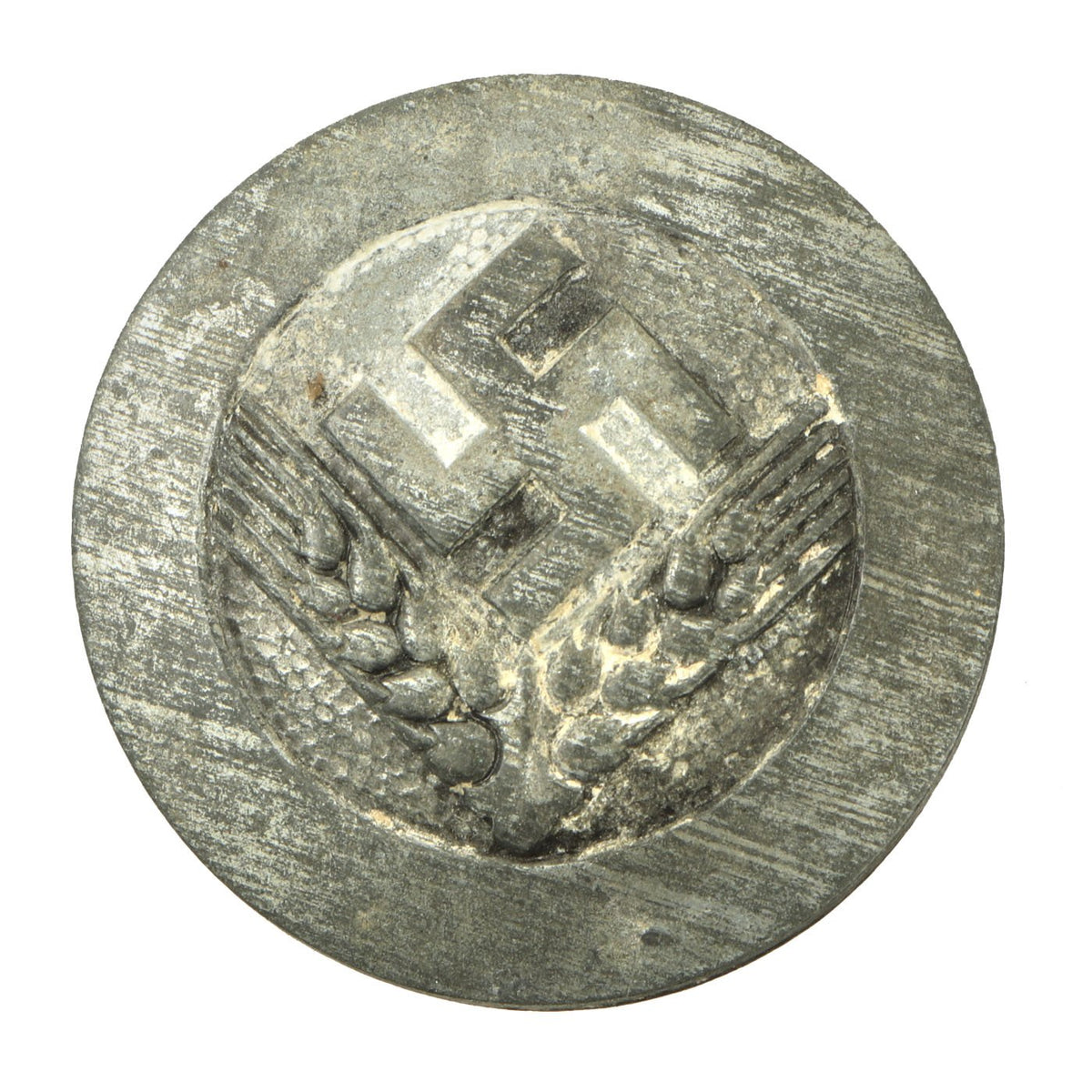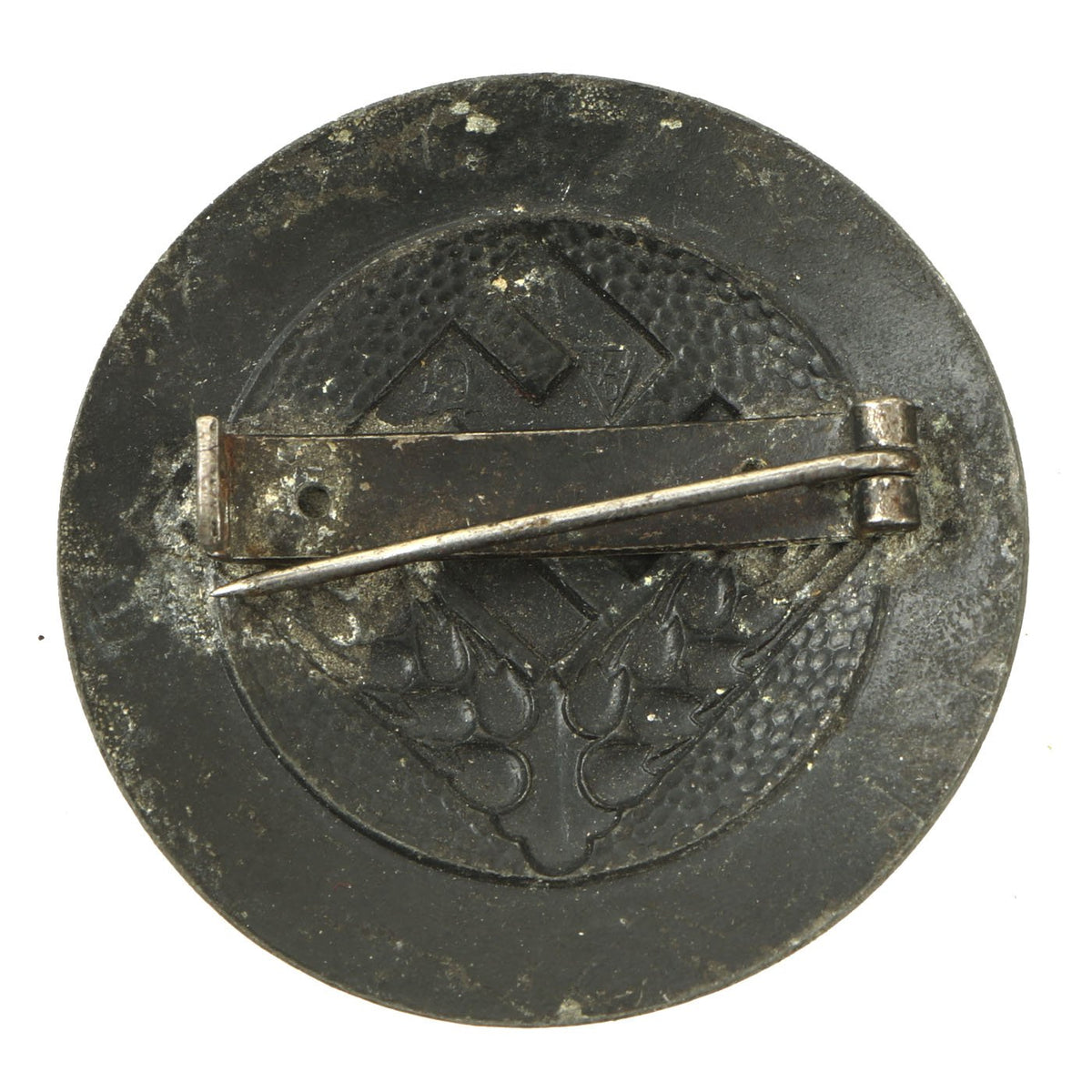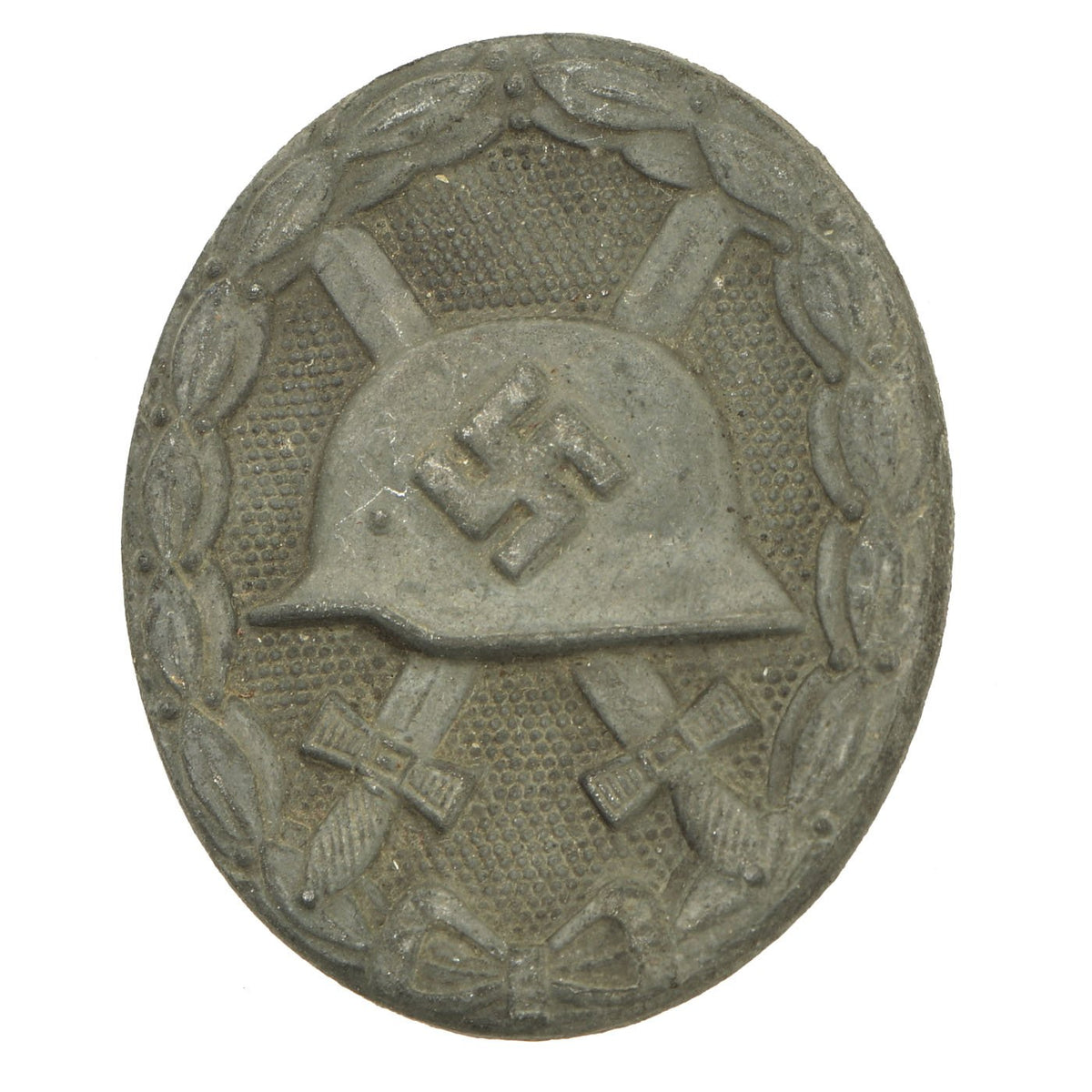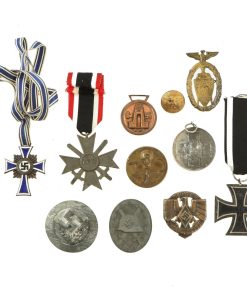Original German WWI & WWII Medal & Insignia Grouping with 1914 EKII & Mother’s Cross – 11 Items Original Items
$ 295,00 $ 118,00
Original Item: One-of-a-kind. This is a very nice collection of German WWII Era awards & insignia, with some from the Post War Weimar and German Empire period. These were most likely brought home by a WWII USGI during or after the war, as medals from Germany were very popular collectors items.
This is a set of 11 items, some of which are military awards, though some are definitely civilian, and others are badges and/or tinnies. There is even a very nice gilt button. They are all in nice displayable condition, with moderate wear. Some have their original ribbons, while others have lost them. As best we can tell, the set consists of the following:
– Imperial German WWI Iron Cross 1914 2nd Class Medal with Ribbon. Marked U on the hanger Ring, an unknown maker.
– German WWII War Merit Cross 2nd Class with Swords and ribbon
– German WWII Cross of Honor of the German Mother in Bronze (3rd Class) with ribbon.
– German WWII Solid Back Silver Wound Badge with intact pinback
– German WWII DRK Red Cross Medal for Social Welfare
– Italian-German WWII African Campaign Medal with intact Bronze Wash
– German WWII RAD Women’s Reich Labor Service Large Pin / Brooch
– German WWII Deutsches Jugendfest 1936 (German Youth Festival 1936) DJ & HJ Tinnie
– German WWII TAG DER ARBEIT 1934 (Labor Day 1934) Tinnie maker marked on reverse: “REICHS VERBAND/ No 11 / PFORZHEIM”
– German WWII Gilt Brass Button by Dr. Franke & Co. of Lüdenscheid, with RZM codes on the reverse
– Germann WWII SA Wettkampstage (Competition Day) Tinnie Badge dated 1938.
This is a great set of medals and other awards from Germany. A great way to start your collection!
Below are descriptions for some of the awards:
German WWI Prussian Iron Cross 2nd Class with Ribbon:
Established by Frederick William in 1813 for gallantry in action, the decoration was revived several times for later conflicts. The bulk of the issues are divided into 1st and 2nd class versions, but a rare and superior ‘Grand Cross’ was also awarded for successful field commanders. During WW1 the lower decoration was freely awarded with 5½ million second class types issued. Originally, the Iron Cross was an award of the Kingdom of Prussia, however given Prussia’s pre-eminent place in the German Empire formed in 1871, it became an award for all of Germany.
The basic design of the WW1 crosses is a central cross patee struck from iron and mounted in a silver frame which has a raised crenulated decorative border. The obverse of the cross bears the date 1914 under a crowned ‘W’ monogram. Reverse bears an oak leaf cluster with the date of the decoration’s institution, 1813 underneath – the crowned initials of Frederick William are in the top arm above the oak leaf cluster. Suspension for second-class types is by means of a ring, and frequently this ring bears a maker’s stamp.
Please examine the edge seam for authentication, which is not present on reproductions. Iron crosses were commonly constructed from an iron core sandwiched in a surrounding two part silver frame, normally the seam of these two silver parts is visible around the edge of the cross as is seen on this fine example.
War Merit Cross 2nd Class (Kriegsverdienstkreuz) with Swords (for Combat)
This was a decoration of NSDAP Germany during the Second World War, which could be awarded to military personnel and civilians alike. By the end of the war it was issued in four degrees, and had a related civil decoration. It was created by Adolf AH in October 1939 as a successor to the non-combatant Iron Cross which was used in earlier wars. The award was graded the same as the Iron Cross: War Merit Cross Second Class, War Merit Cross First Class, and Knights Cross of the War Merit Cross. The award had two variants: with swords given to soldiers for exceptional service “not in direct connection with combat”, and without swords for meritorious service to civilians in “furtherance of the war effort”. As with the Iron Cross, Recipients had to have the lower grade of the award before getting the next level.
The Cross of Honor of the German Mother (German: Ehrenkreuz der Deutschen Mutter), referred to colloquially as the Mutterehrenkreuz (Mother’s Cross of Honour) or simply Mutterkreuz (Mother’s Cross), was a state decoration conferred by the government of the German Reich to honour a Reichsdeutsche German mother for exceptional merit to the German nation. Eligibility later extended to include Volksdeutsche (ethnic German) mothers from, for example, Austria and Sudetenland, that had earlier been incorporated into the German Reich.
The decoration was conferred from 1939 until 1945 in three classes: bronze, silver, and gold, to Reichsdeutsche mothers who exhibited probity, exemplary motherhood, and who conceived and raised at least four or more children in the role of a parent. A similar practice, that continues to this present day, was already established in France since 1920, by conferring the Médaille de la Famille française (Medal of the French Family), a tribute to the French mother who raised several children in an appropriate way.
The German Wound Badge (Verwundetenabzeichen) was instituted during the First World War to recognize those wounded in the conflict. It was designed using a World War One style Imperial German helmet as the main motif. The helmet was set on top two crossed swords against a pebbled background and surrounded by a laurel leaves wreath.
At the outbreak of war in September 1939 with Poland, Adolf AH once again reinstated the Wound Badge Award. Again the pattern of the badge was similar to that of the earlier style except the new design was freshened up a bit by using an M35 pattern German helmet and a slightly softer looking wreath. This pattern was used until the end of the war in 1945. It is impossible to know the exact numbers of wound badges awarded during the course of the Second World War due to the vast scale and countless individuals who were wounded or killed in the conflict.
The Wound Badge Awards came in three different types of grades representing the amount , or severity, of wounds received. The first grade, the Black Wound Badge was awarded for 1 to 2 wounds received in combat. The Silver Grade was awarded for 3 to 4 wounds, and finally the Gold Grade for 5 or more wounds, total disability, or death.
The German DRK Social Welfare Decoration (German: Ehrenzeichen für deutsche Volkspflege) was a German Civil Award created by Adolf AH on 1 May 1939 for services in the social sector. The decoration was issued in three classes and was awarded for a wide variety of service, in the social sector, to the German state. Qualifying service would have been with Winterhilfswerk, National Socialist People’s Welfare, medical and rescue work, or care of foreign and ethnic Germans. As a replacement for the German Red Cross Decoration, it was conferred in four classes consisting of a white-enameled gold Balkenkreuz with Reich eagle and swas. A “Medal for Social Welfare” was also issued for lesser degrees of service, not warranting the higher presentation of a class award.
Fast Shipping with Professional Packaging
Thanks to our longstanding association with UPS FedEx DHL, and other major international carriers, we are able to provide a range of shipping options. Our warehouse staff is expertly trained and will wrap your products according to our exact and precise specifications. Prior to shipping, your goods will be thoroughly examined and securely secured. We ship to thousands clients each day across multiple countries. This shows how we're dedicated to be the largest retailer on the internet. Warehouses and distribution centres can be located throughout Europe as well as the USA.
Note: Orders with more than one item will be assigned a processing date depending on the item.
Before shipping before shipping, we'll conduct a thorough inspection of the items you have ordered. Today, the majority of orders will be delivered within 48 hours. The delivery time will be between 3-7 days.
Returns
The stock is dynamic and we cannot completely manage it because multiple stakeholders are involved, including our factory and warehouse. So the actual stock may alter at any time. It's possible that you may not receive your order once the order has been made.
Our policy is valid for a period of 30 days. If you don't receive the product within 30 days, we are not able to issue a refund or an exchange.
You can only return an item if it is unused and in the same state as the day you received it. You must have the item in its original packaging.
Related products
Uncategorized
Angolan Rebel 1970s era 60mm Inert Display Mortar from Angolan Civil War Original Items
Uncategorized
Uncategorized
Australian WWII Owen MK1 Machine Carbine SMG Custom Fabricated Replica with Sling Original Items
Uncategorized
Uncategorized
Uncategorized
Uncategorized
Uncategorized
Uncategorized
Uncategorized
Uncategorized
Uncategorized
Uncategorized
Uncategorized
Uncategorized
Uncategorized
Uncategorized
Uncategorized
Armoured Fighting Vehicles of the World: AFVs of World War One (Hardcover Book) New Made Items
Uncategorized
Band of Brothers ORIGINAL GERMAN WWII Le. F.H. 18 10.5cm ARTILLERY PIECE Original Items
Uncategorized
Armored Burgonet Helmet & Polearm from Scottish Castle Leith Hall Circa 1700 Original Items
Uncategorized
